Nine-Piece Pottery Polychrome Nacimiento by Dorothy Loretto Trujillo - C3848
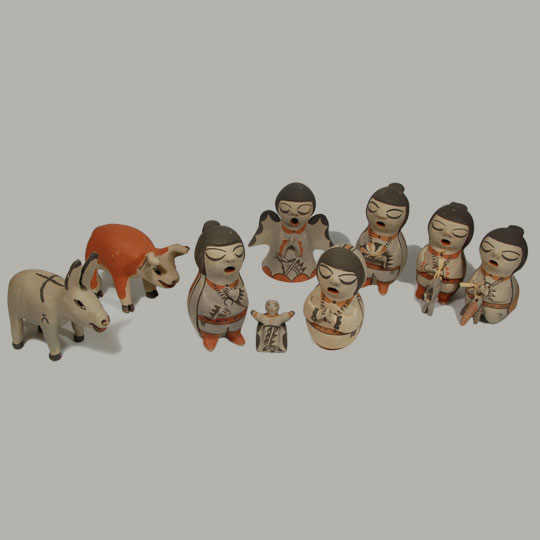 Dorothy Loretto Trujillo, who passed away in 1999, was an outstanding potter. She was originally from Jemez Pueblo, but moved to Cochiti following her marriage to Onofre Trujillo, and obtained permission to make pottery using Cochiti clay. After moving to Cochiti Pueblo, Dorothy started making pottery in the Cochiti style, abandoning her Jemez style.
Dorothy Loretto Trujillo, who passed away in 1999, was an outstanding potter. She was originally from Jemez Pueblo, but moved to Cochiti following her marriage to Onofre Trujillo, and obtained permission to make pottery using Cochiti clay. After moving to Cochiti Pueblo, Dorothy started making pottery in the Cochiti style, abandoning her Jemez style.
Dorothy was one of the early potters to make storytellers. She was from a family of outstanding potters. Her sisters, Mary E. Toya, Marie Edna Coriz, Alma Concha Loretto, Fannie Wall Loretto, and Lenora Lupe Lucero, are famous potters as well. Interestingly, her sisters also married out of their native pueblo and moved to the pueblo of their spouses. Dorothy began making Storytellers before 1970. Two years later, she began making Nativities (Nacimientos). Dorothy shared her pottery-making knowledge with others. She had taught at least three people, including two of her own daughters. Her Storytellers may have only one or over 40 babies. One of her Storytellers is on exhibit at the Smithsonian Institution, Museum of Natural History, Washington, D.C.
Miniature Akimel O' Odham - Pima Basket with Turtle Design - C3353.03
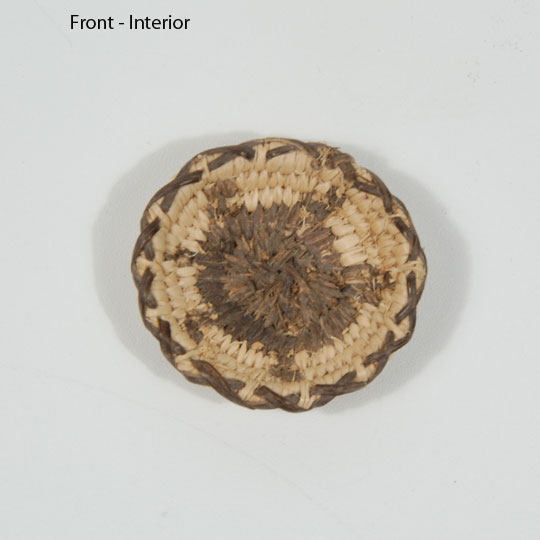 The Akimel O´odham River People (Pima) of Arizona were major basket makers in the late 19th century, primarily making them for their own use. At the turn of the century, basket weaving was being practiced in every home. This continued into the early 20th century, at which time Southwest Indian basketry became a collectible commodity. The problem was that the collectors and dealers only paid $1.00 to $3.00 for a basket. The women soon realized that it was not practical to spend weeks making a basket when they could pick cotton and earn $2.00 a day. By the 1920s, basket weaving all but disappeared. By 1960, they were not even making baskets for their own use. They had, by then, substituted commercially made pots and pans for utilitarian use.
The Akimel O´odham River People (Pima) of Arizona were major basket makers in the late 19th century, primarily making them for their own use. At the turn of the century, basket weaving was being practiced in every home. This continued into the early 20th century, at which time Southwest Indian basketry became a collectible commodity. The problem was that the collectors and dealers only paid $1.00 to $3.00 for a basket. The women soon realized that it was not practical to spend weeks making a basket when they could pick cotton and earn $2.00 a day. By the 1920s, basket weaving all but disappeared. By 1960, they were not even making baskets for their own use. They had, by then, substituted commercially made pots and pans for utilitarian use.
Polacca Polychrome Inspiration for a Contemporary Jar by Mark Tahbo - 25911
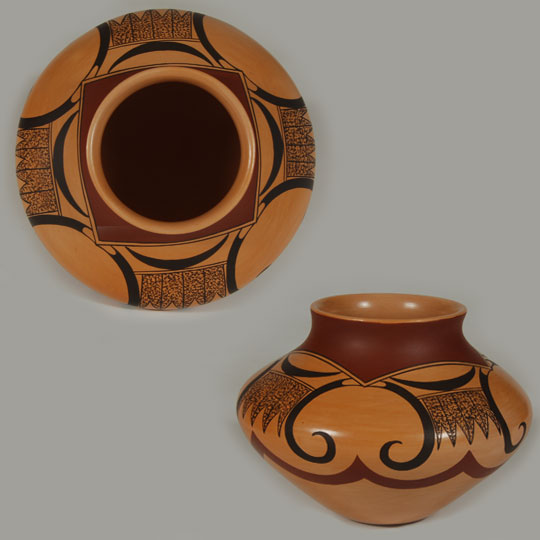 Mark Tahbo often uses historic and prehistoric examples of Hopi pottery as his inspiration when creating designs on new vessels. He, by doing this, keeps the continuity of Hopi ceramics alive and brings the older designs back to the attention of today's collectors.
Mark Tahbo often uses historic and prehistoric examples of Hopi pottery as his inspiration when creating designs on new vessels. He, by doing this, keeps the continuity of Hopi ceramics alive and brings the older designs back to the attention of today's collectors.
This medium-size jar was inspired by a Hopi Polacca Polychrome jar (Sikyatki Revival), dating from 1890-1900, that was in the Thomas Keam collection and now resides at the Peabody Museum at Harvard University. At the time that Alexander M. Stephen cataloged the Keam collection, he categorized Polacca Polychrome as "modern" pottery because it was being made at the time he was working with Keam on documenting his collection. Modern pottery of that time (1890-1900) is now considered historic pottery.
Hopi Pueblo Pictorial Tile with Crow Mother Image by Gwen Setalla - C3843N
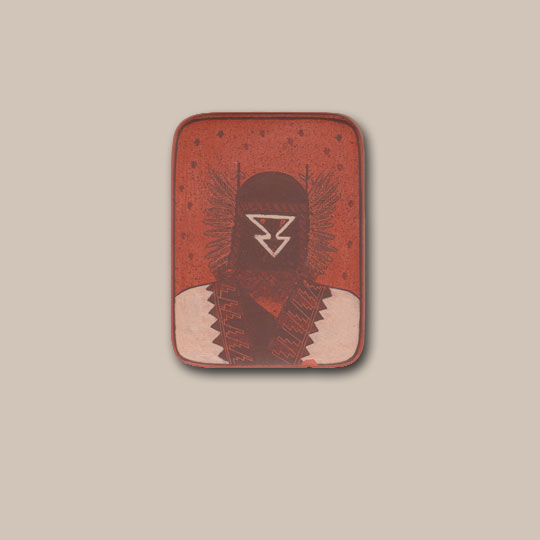 Gwen Sharon Setalla (b.1964-) Aȁs-kữ-Mana is a Hopi from the village of Mishongnovi on Second Mesa. Her mother is Pauline Setalla from Mishongnovi. They are of the Frog Woman and Feather Woman families. The family lived on a ranch not far from Keams Canyon and Gwen spent her early childhood there. She learned pottery making from her mother, starting as early as age 5 and began to take it seriously by age 21.
Gwen Sharon Setalla (b.1964-) Aȁs-kữ-Mana is a Hopi from the village of Mishongnovi on Second Mesa. Her mother is Pauline Setalla from Mishongnovi. They are of the Frog Woman and Feather Woman families. The family lived on a ranch not far from Keams Canyon and Gwen spent her early childhood there. She learned pottery making from her mother, starting as early as age 5 and began to take it seriously by age 21.
Very Large Hopi Polychrome Seed Jar by Debbie Clashin - 25862
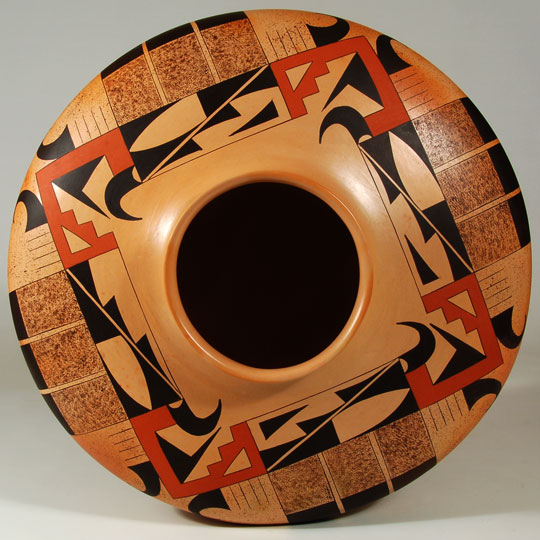 This very large Hopi Pueblo seed jar was made by Debbie Clashin, a potter we met through Hopi potter Mark Tahbo. Mark's mother and Debbie's mother were sisters. Debbie credits Mark's sister, Diana Tahbo, with teaching her how to become a potter and now Debbie produces amazing large Hopi seed jars. This jar is over a foot in diameter.
This very large Hopi Pueblo seed jar was made by Debbie Clashin, a potter we met through Hopi potter Mark Tahbo. Mark's mother and Debbie's mother were sisters. Debbie credits Mark's sister, Diana Tahbo, with teaching her how to become a potter and now Debbie produces amazing large Hopi seed jars. This jar is over a foot in diameter.
Original Etching and Drypoint “Taos” by Edward Borein - C3827H
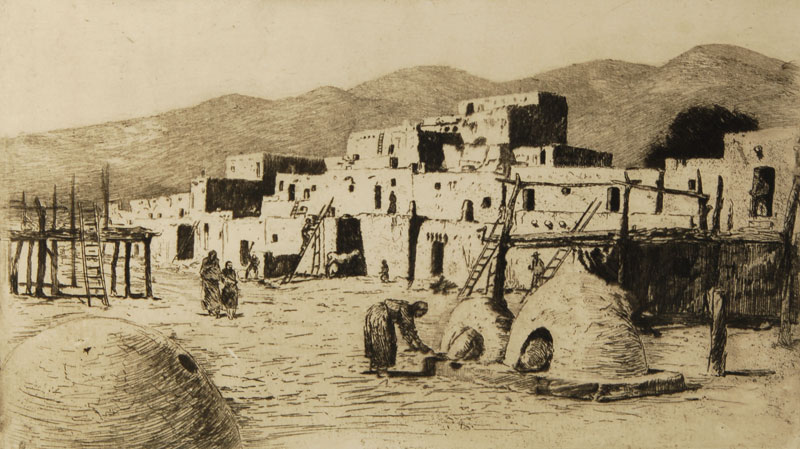 Like almost every artist who has visited New Mexico, Edward Borein (1873-1945) provides us with his rendition of Taos Pueblo. A Taos woman tends to her bread that is baking in the horno, a Taos Indian is climbing a ladder to get to the second level of the terrace house, a couple of people are walking, one is standing in a doorway on the right, and a horse is standing near a building.
Like almost every artist who has visited New Mexico, Edward Borein (1873-1945) provides us with his rendition of Taos Pueblo. A Taos woman tends to her bread that is baking in the horno, a Taos Indian is climbing a ladder to get to the second level of the terrace house, a couple of people are walking, one is standing in a doorway on the right, and a horse is standing near a building.
Original Etching and Drypoint “The Antelope Kiva, Walpi” by Edward Borein - C3827G
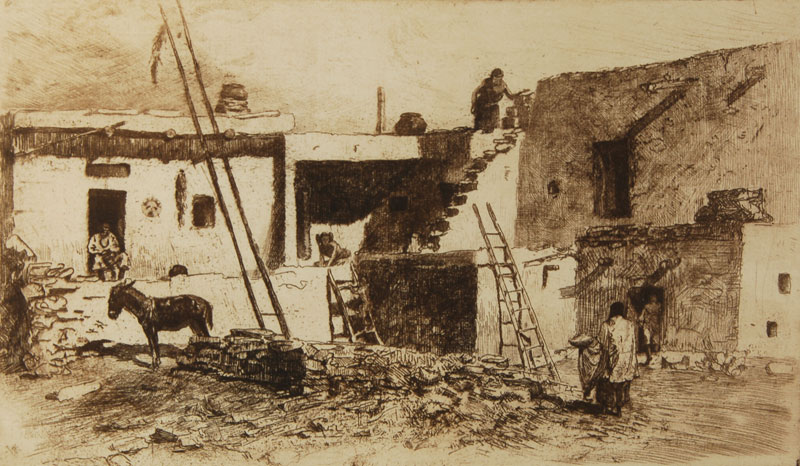 Edward Borein was born at San Leandro, California, not far from San Francisco, in 1873. He began to work as a cowboy at the age of seventeen, and sold his first drawing when he was twenty-one. From that time onward, irrespective of location as he travelled all over the Southwestern United States and as far south as Guatemala, he was an artist. He remained ever devoted to the practice of his professional skill, and at the same time kept up his interest in cowboy life, to the very end.
Edward Borein was born at San Leandro, California, not far from San Francisco, in 1873. He began to work as a cowboy at the age of seventeen, and sold his first drawing when he was twenty-one. From that time onward, irrespective of location as he travelled all over the Southwestern United States and as far south as Guatemala, he was an artist. He remained ever devoted to the practice of his professional skill, and at the same time kept up his interest in cowboy life, to the very end.
Borein also knew the Pueblo Indians and drew them and their villages. It is not known what years Borein visited the Pueblo villages and put his thoughts on paper in the etching process but it would have been in the late 1800s or early 1900s.
Original Painting “Weaving a Navajo Dress” by Gerald Nailor - 25895
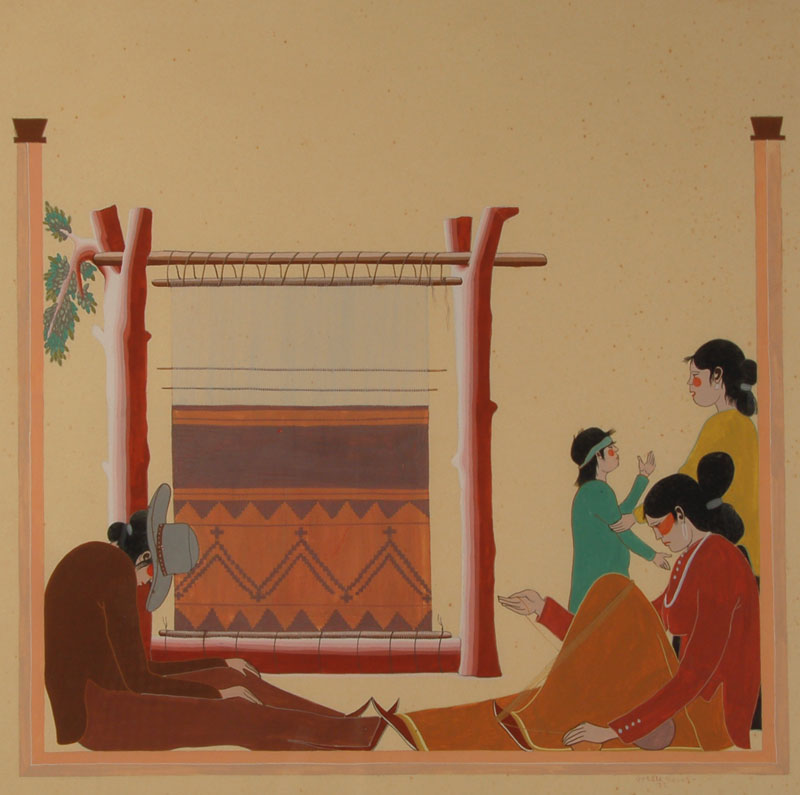 Gerald Nailor (1917-1952) painted in a decorative manner unlike any other Navajo artist. His style was unique and quite recognizable. He generally painted in soft matte colors.
Gerald Nailor (1917-1952) painted in a decorative manner unlike any other Navajo artist. His style was unique and quite recognizable. He generally painted in soft matte colors.
"In 1937, Nailor shared a studio in Santa Fe with Allan Houser. His paintings were exhibited in the home of Mrs. Hall Adams from 1943 to 1952. At the time of his death, he was living with his family at Picuris Pueblo, NM. Tragically, Nailor was only 35 years old when [he] died from injuries received in an attempt to help a woman whose husband was brutally beating her." -Snodgrass, 1968.
Hopi Pueblo Sikyatki-Revival Polychrome Jar by Mark Tahbo - 25910
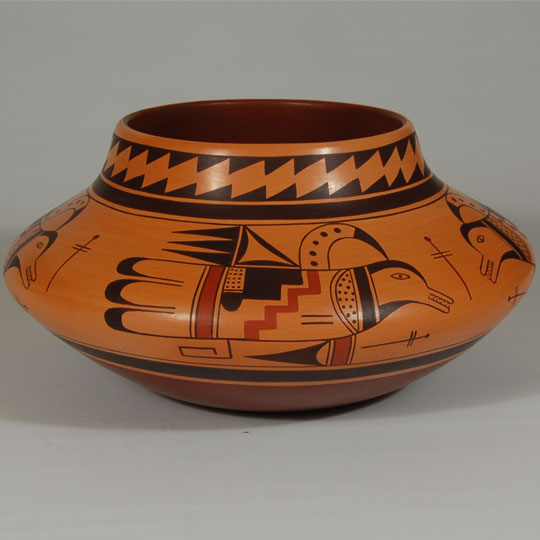 Mark Tahbo, great-grandson of Hopi-Tewa potter Grace Chapella, was inspired by the two previous jars and created his version of the same. It is not a copy of the two previous jars, but a jar inspired by those. The mythological bird-like figures are similar, but different, with the same elements previously described by Alexander Stephen for the Sikyatki jar. So, there is a Sikyatki pre-historic jar, a later Polacca Polychrome follow-up jar, and now a contemporary Hopi jar to continue the Hopi mythology of the Thunder bird. Mark Tahbo used Sikyatki clay for this new jar.
Mark Tahbo, great-grandson of Hopi-Tewa potter Grace Chapella, was inspired by the two previous jars and created his version of the same. It is not a copy of the two previous jars, but a jar inspired by those. The mythological bird-like figures are similar, but different, with the same elements previously described by Alexander Stephen for the Sikyatki jar. So, there is a Sikyatki pre-historic jar, a later Polacca Polychrome follow-up jar, and now a contemporary Hopi jar to continue the Hopi mythology of the Thunder bird. Mark Tahbo used Sikyatki clay for this new jar.
Hopi Pueblo Painting of a Soyal Katsina by Peter Shelton (Hoyesva) - C3839E
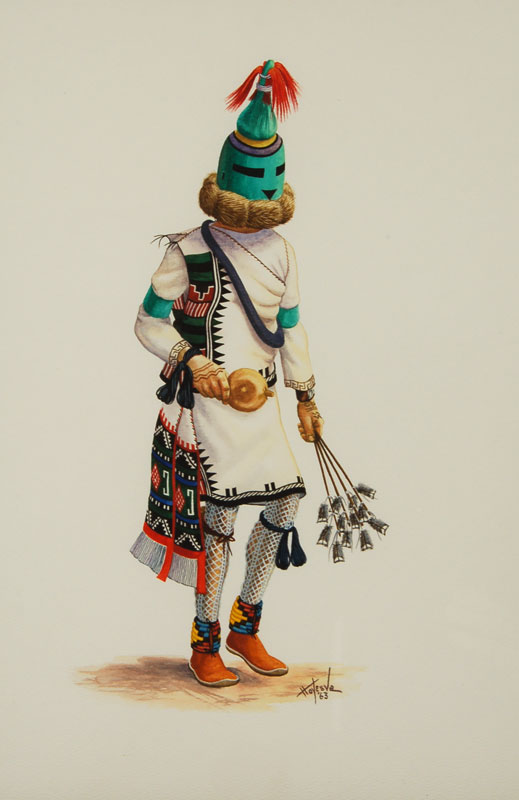 Peter Shelton ( - ) Hoyesva - Wherever the Arrow Lands was born in the Hopi Pueblo village of Oraibi, where he received his early education. He was also educated at the Santa Fe Indian School. Though usually recognized as a painter, Shelton was also a carver of Katsina dolls. That he took a keen interest in Katsina dolls is evident even in his paintings. The dancers featured in his paintings are often depicted in stances like those of Kachina dolls. They are tall and slender, and are often decorated with a variety of bright colors. Particular attention is given to the Katsinas' ceremonial clothing.
Peter Shelton ( - ) Hoyesva - Wherever the Arrow Lands was born in the Hopi Pueblo village of Oraibi, where he received his early education. He was also educated at the Santa Fe Indian School. Though usually recognized as a painter, Shelton was also a carver of Katsina dolls. That he took a keen interest in Katsina dolls is evident even in his paintings. The dancers featured in his paintings are often depicted in stances like those of Kachina dolls. They are tall and slender, and are often decorated with a variety of bright colors. Particular attention is given to the Katsinas' ceremonial clothing.
Zuni Pueblo Multi-Stone Butterfly Pin, circa 1920 - C3837J
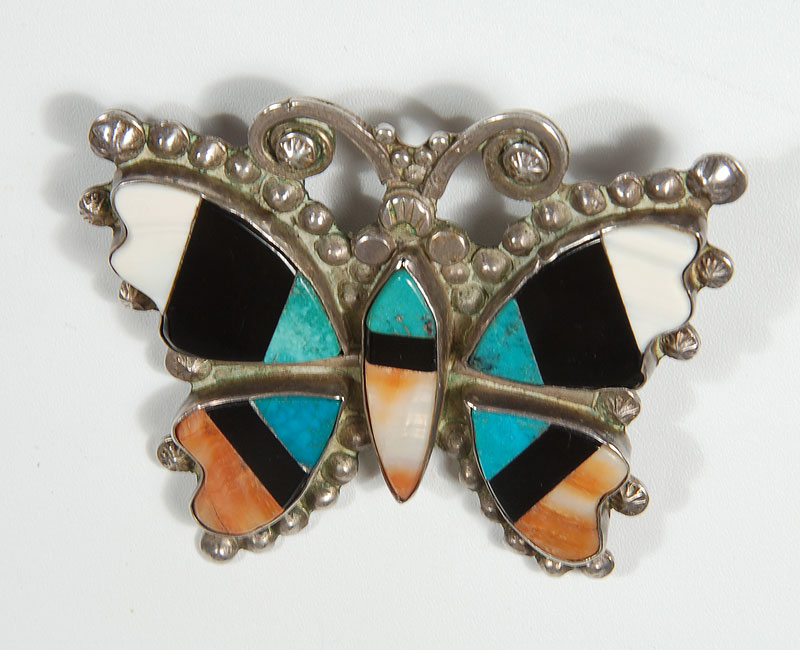 Zuni artisans are praised for their masterful lapidary work. They have achieved the ultimate in cutting stones so that they fit together in a stone-to-stone manner as tightly as the Inca set massive stones together without the use of mortar. This Zuni Pueblo Multi-Stone Butterfly Pin, circa 1920, is an excellent example of such fine work. Each stone fits the adjoining stone beautifully.
Zuni artisans are praised for their masterful lapidary work. They have achieved the ultimate in cutting stones so that they fit together in a stone-to-stone manner as tightly as the Inca set massive stones together without the use of mortar. This Zuni Pueblo Multi-Stone Butterfly Pin, circa 1920, is an excellent example of such fine work. Each stone fits the adjoining stone beautifully.
Navajo Drawing of a Campfire Gathering by Robert Draper - C3827F
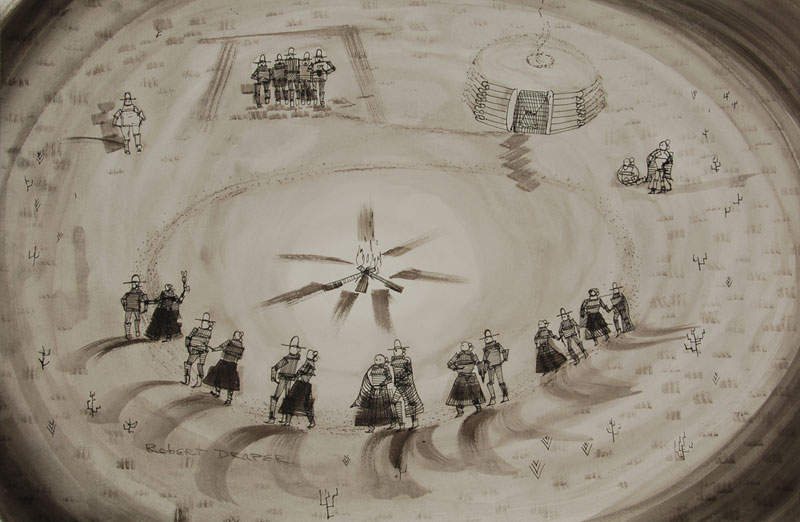 Navajo artist Robert Draper was the child of a Navajo mother and a Hopi-Laguna father. Raised by his grandparents on the Navajo Reservation, he attended-and eventually became an instructor at- the Chinle Boarding School. He was also educated at the Inter-Mountain Indian School in Utah and the Institute of America Indian Arts in Santa Fe. Draper mostly painted realistic landscapes, focusing on everyday life on the Navajo Reservation.
Navajo artist Robert Draper was the child of a Navajo mother and a Hopi-Laguna father. Raised by his grandparents on the Navajo Reservation, he attended-and eventually became an instructor at- the Chinle Boarding School. He was also educated at the Inter-Mountain Indian School in Utah and the Institute of America Indian Arts in Santa Fe. Draper mostly painted realistic landscapes, focusing on everyday life on the Navajo Reservation.
Tesuque Pueblo Painting of Foxes Attacking a Bison by Ku Se Peen - C3827C
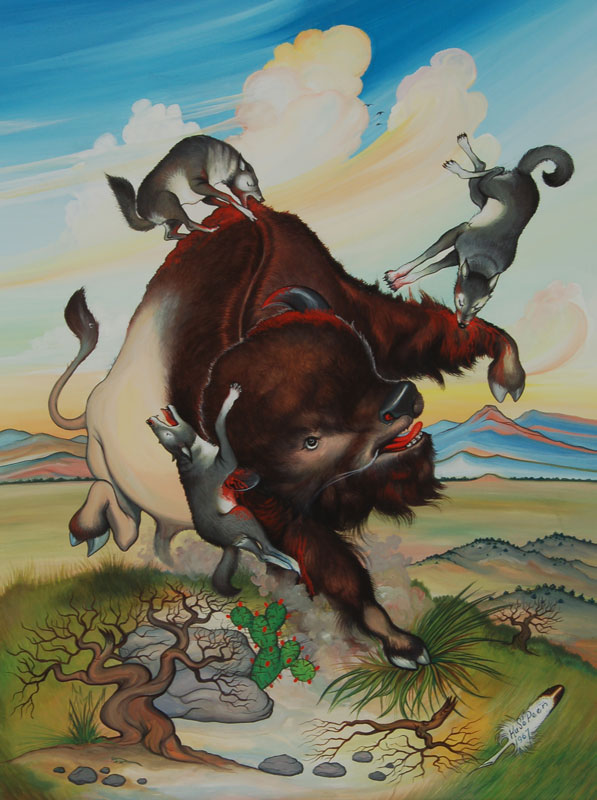 Tesuque Pueblo painter Tim Vigil ( - ) Ku Se Peen - Rocky Mountain was the son of Thomas Vigil, one of the earliest 20th century Pueblo painters, and the brother of Paul Vigil. Thomas Vigil worked almost exclusively within the confines of the two-dimensional "flat-style" of painting for which he and his peers are well-known today, and the few available published examples of Tim and Paul's work are also in keeping with this traditional style.
Tesuque Pueblo painter Tim Vigil ( - ) Ku Se Peen - Rocky Mountain was the son of Thomas Vigil, one of the earliest 20th century Pueblo painters, and the brother of Paul Vigil. Thomas Vigil worked almost exclusively within the confines of the two-dimensional "flat-style" of painting for which he and his peers are well-known today, and the few available published examples of Tim and Paul's work are also in keeping with this traditional style.
Creek Indian Buffalo Dancer Painting by Danny Russell Kaler - C3839B
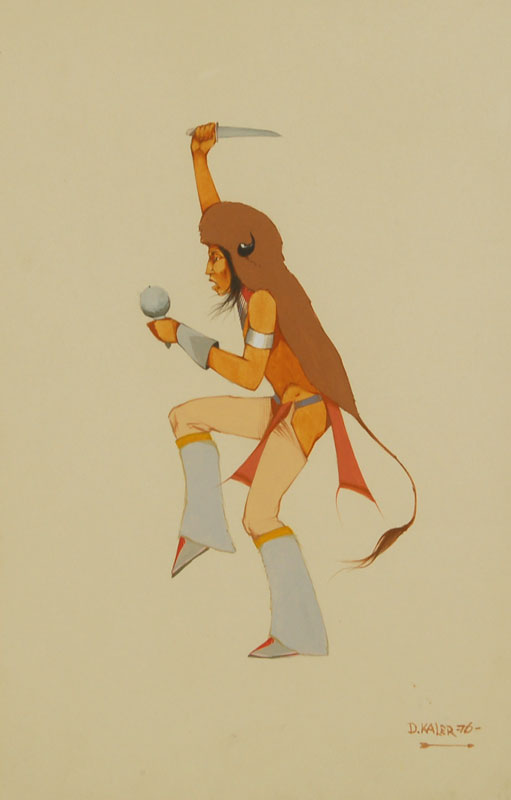 Danny Russell Kaler is an enrolled member of the Muskogee Creek Nation. There is very little information published on the artist but it is documented that his work has been exhibited at the Cherokee National Museum; the Five Civilized Tribes Museum; and the Philbrook Art Center. He received awards from the Five Civilized Tribes Museum in 1971, 1972, 1973 and 1985, the latter two being 1st Prizes.
Danny Russell Kaler is an enrolled member of the Muskogee Creek Nation. There is very little information published on the artist but it is documented that his work has been exhibited at the Cherokee National Museum; the Five Civilized Tribes Museum; and the Philbrook Art Center. He received awards from the Five Civilized Tribes Museum in 1971, 1972, 1973 and 1985, the latter two being 1st Prizes.
This painting of a single Buffalo Dancer is dated 1976. It is painted without ground plane or other distracting items such as trees or clouds.
Hopi Pueblo Tasap Yeibichai Katsina Doll, circa 1950 - C3535.02
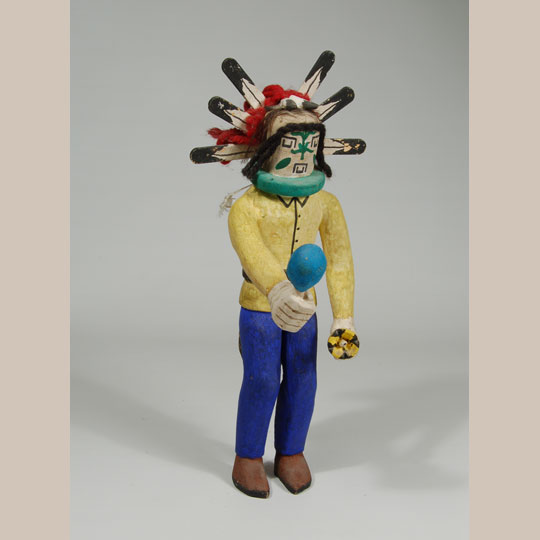 "The Grandfather of the Navajo Kachina is one of the more enjoyable features of the Navajo Kachina Dance. He does not speak but pantomimes whatever he wants. He starts the dance, acting as a leader in both singing and dancing. His dance step is an exaggeration, and a very lively one, that may be interspersed with a comic action such as the request for food-mountains of food. All of these requests are done in pantomimes that bring laughter to the audience." Wright 1973
"The Grandfather of the Navajo Kachina is one of the more enjoyable features of the Navajo Kachina Dance. He does not speak but pantomimes whatever he wants. He starts the dance, acting as a leader in both singing and dancing. His dance step is an exaggeration, and a very lively one, that may be interspersed with a comic action such as the request for food-mountains of food. All of these requests are done in pantomimes that bring laughter to the audience." Wright 1973
Hopi Pottery Tile with Unidentified Katsina Face by Barbara Polacca - C3843P
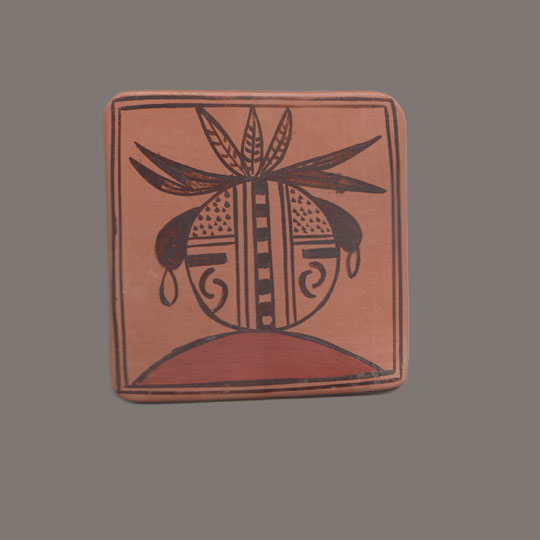 Barbara Polacca is a Hopi-Tewa of the Spider Clan who has been an active potter since 1970. She is an accomplished potter known for making seed jars, cylindrical vases, bowls, canteens and tiles. She painted the face of a katsina on this tile. Tiles have been a popular collector's item for over a hundred years. The Hopi-Tewa potters have always been more prolific than the Rio Grande Pueblos in making them.
Barbara Polacca is a Hopi-Tewa of the Spider Clan who has been an active potter since 1970. She is an accomplished potter known for making seed jars, cylindrical vases, bowls, canteens and tiles. She painted the face of a katsina on this tile. Tiles have been a popular collector's item for over a hundred years. The Hopi-Tewa potters have always been more prolific than the Rio Grande Pueblos in making them.
Hopi Pueblo Sakwatsmana Katsina Doll by Jimmie Koots - C3843E
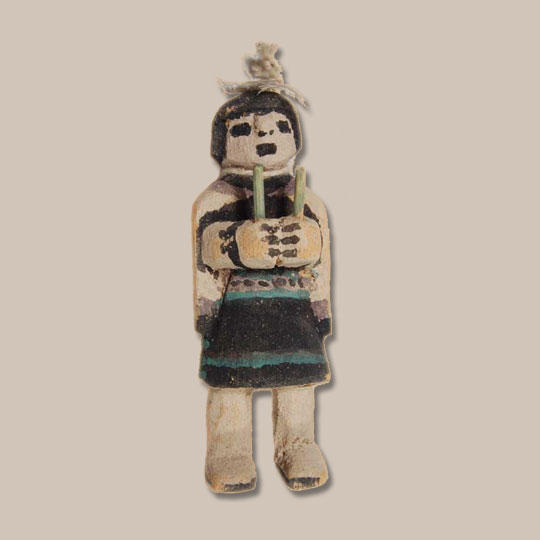 James Kootshongsie (1916-1996) Jimmie Koots is a well-known carver of Katsina dolls in the Santa Fe area because his dolls were featured at a shop called Rare Things by Dutton in downtown Santa Fe for years and years. His full name is James Kootshongsie. He had a fascinating life and we have printed information from the book "Hopi Katsina 1,600 Artist Biographies" by Greg Schaaf. To see this biography, click on the artist's name just below the picture of the Katsina doll.
James Kootshongsie (1916-1996) Jimmie Koots is a well-known carver of Katsina dolls in the Santa Fe area because his dolls were featured at a shop called Rare Things by Dutton in downtown Santa Fe for years and years. His full name is James Kootshongsie. He had a fascinating life and we have printed information from the book "Hopi Katsina 1,600 Artist Biographies" by Greg Schaaf. To see this biography, click on the artist's name just below the picture of the Katsina doll.
Painting of an Adobe House and Landscape by Samuel D. Smith - C3831B
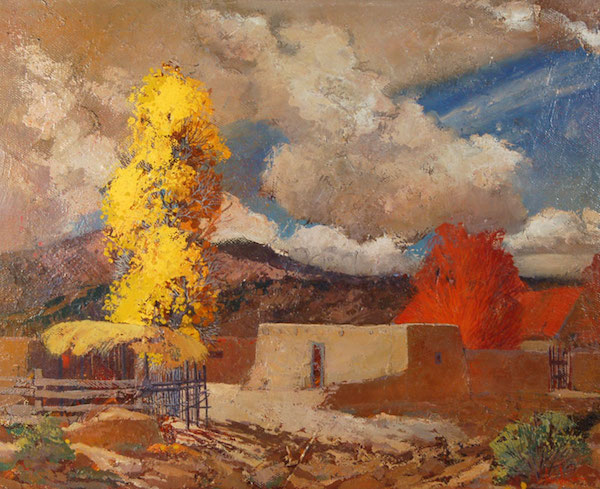 Early 20th-century artists from the East and Midwest were drawn to New Mexico's charming settings of a brown adobe building set amongst cottonwood and aspen trees, under a blue sky with billowing white clouds, and a backdrop of a mountain. It was romantic, quiet, beautiful, restful, and begging to be captured on canvas.
Early 20th-century artists from the East and Midwest were drawn to New Mexico's charming settings of a brown adobe building set amongst cottonwood and aspen trees, under a blue sky with billowing white clouds, and a backdrop of a mountain. It was romantic, quiet, beautiful, restful, and begging to be captured on canvas.
That is just the scene Samuel D. Smith (1918-1999) captured in this small painting. The low brown mud building is snuggled in a restful landscape of brown dirt and green plants. Framing the painting is a flaming red tree and a brilliant yellow one. The blue sky is almost obliterated with dark rain clouds. The mountain in the background adds a solid anchor. The red pitch-roof barn building behind the flat-top adobe identifies the location as northern New Mexico where snow accumulation is abundant.
Cochiti Pueblo 17-piece Pottery Nacimiento, 1972 by Helen Cordero - 25522
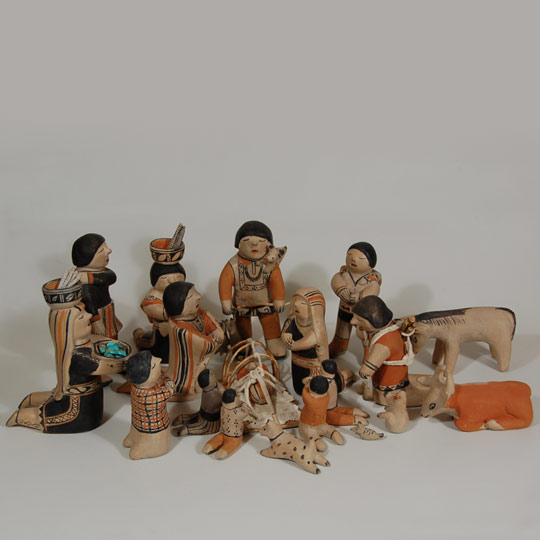 In 1972, Helen Cordero made this 17-piece nacimiento for a friend in Albuquerque. The addition of children and puppies to the scene is a Helen Cordero trademark. Her cattle always bear the Cochiti brand. Her people have their eyes closed and mouths open as in all her other figurine pottery. Helen said she made nacimientos the way it is traditional at Cochiti-the clothes they wear, the gifts they bring, and the animals of the pueblo. She never used sheep because there are none at Cochiti.
In 1972, Helen Cordero made this 17-piece nacimiento for a friend in Albuquerque. The addition of children and puppies to the scene is a Helen Cordero trademark. Her cattle always bear the Cochiti brand. Her people have their eyes closed and mouths open as in all her other figurine pottery. Helen said she made nacimientos the way it is traditional at Cochiti-the clothes they wear, the gifts they bring, and the animals of the pueblo. She never used sheep because there are none at Cochiti.
Cochiti Pueblo Five Piece Pottery Nacimiento by Felicita Eustace - C3688.79
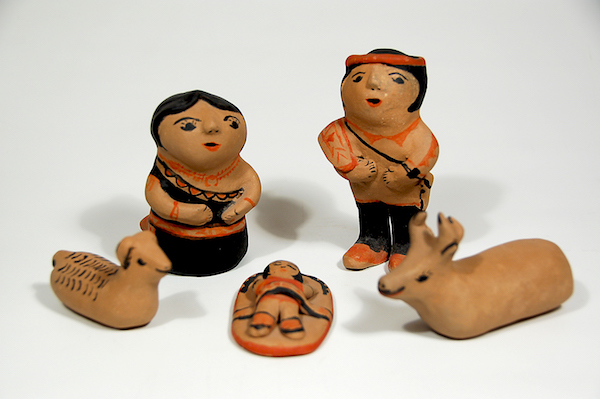 At 88 years of age, Felicita Eustace is still working making storyteller figurines, using all native materials and firing in the traditional outdoor firing process. She told me that she still has clay that her husband, Ben, gathered for her years ago so she doesn't have to worry about digging clay at this time. She is so small and petit, probably less than 100 pounds, that I hope she does not ever have to dig clay. The last time I saw her, over a year ago, her grandson was driving her around.
At 88 years of age, Felicita Eustace is still working making storyteller figurines, using all native materials and firing in the traditional outdoor firing process. She told me that she still has clay that her husband, Ben, gathered for her years ago so she doesn't have to worry about digging clay at this time. She is so small and petit, probably less than 100 pounds, that I hope she does not ever have to dig clay. The last time I saw her, over a year ago, her grandson was driving her around.

